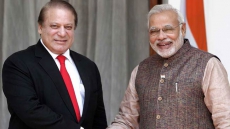An Indian American student won the prestigious Intel Foundation Young Scientist Award Friday, while nine students from across India won awards in various categories and five US students were awarded science trips to India at the Intel International Science and Engineering Fair (IISEF) in Pttsburgh.
The IISEF honors the world's most promising high school student scientists, inventors and engineers selected through rigorous competitions held around the world. Many past winners have gone on to win Nobel Prizes and other prestigious awards.
For his work on refining a system to help protect the seas from oil-drilling disasters, Karan Jerath, 18, of Friendswood, Texas, received the $50,000 Young Scientist Award, the second highest prize at the IISEF.
Jerath was also one of the five students selected for the Intel and Indo-US Science and Technology Forum Visit to India Award. They will receive a weeklong visit to India to showcase their research projects, visit research leading institutions and interact with top scientists.
Onkar Singh Gujral, 18, of La Martiniere for Boys in Kolkata, won the Association of Computing Machinery first award and the second award in the System software category for his entry on image processing algorithms for detecting nanomaterials.
The other Indian winners came from Delhi, Kozhikode, Mangalore and Panipat.
An Indian American foundation, gave ten awards at the Fair. Sanjana J. Rane, 17, of Louisville, Kentucky, received the first award for work relating to renal fibrosis from the Ashtavadhani Vidwan Ambati Subbaraya Chetty Foundation based in Georgia. Five American students of Indian descent were among those who received the foundations second awards.
About 1,700 students who participated at the IISEF in Pittsburgh were the top performers at 422 affiliated fairs held in 75 countries. At the IISEF their projects went through rigorous evaluations by about 1,000 judges with PhDs or equivalent qualifications from across scientific disciplines.
Seventeen students from India were selected for the IISEF from the National Science Fair held by Initiative for Research and Innovation in Science.
Maya Ajmera, who is Indian descent and heads the Society for Science and the Public that conducts the IISEF, congratulated the winners and said, "These talented young students are the problem solvers and innovators of their generation."
The top prize, the $75,000 Gordon E. Moore Award, went to Raymond Wang, 17, of Canada.

Scores of Indian American students won awards in various categories, five of them getting the first award in their specialisations, biochemistry, behavioral sciences, environmental engineering, mathematics and energy physics.
More than 200 Indian American students were among the finalists at the IISEF, having won regional competitions across the US. In addition, students of Indian descent came from South Africa, Malaysia and Singapore.
These are the other winners from schools in India:
* Mansi Aggarwal, 17, and Harshit Jindal, 14, of Maharaja Agarsain Public School, Delhi: Fourth Award in Plant Sciences category for research on "An Effective Herbal Ointment against Enterobiasis"
* Ravi Pradip, 17, of Dayapuram Residential School, Kozhikode, Kerala: Third Place in Material Sciences for work on "Plumeria Blooms for Organic Electronics"
* Arsh Shah Dilbagi, 17, of DAV Public School, Panipat, Haryana, Third Award in Embedded Systems category for developing "TALK-An AAC Device: Converting Breath into Speech for the Disabled"
* Mansi Aggarwal, 17, and Harshit Jindal, 14, of Maharaja Agarsain Public School, Delhi: Fourth Award in Plant Sciences category for research on "An Effective Herbal Ointment against Enterobiasis"
* Aditya Bhargava, 16, and Komal S, 16, of Sharada Vidyanikethana Public School, Mangalore, Karnataka: Fourth Award in Material Sciences for work on "Highly Sensitive Nano-Ferrite for Detection of Carbon Monoxide in Air"






